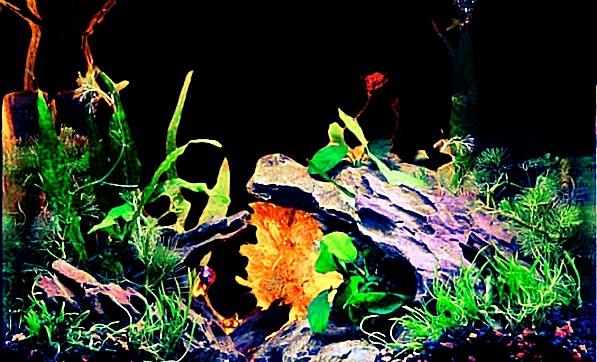I began my project for two primary reasons.
First, after a client purchased a 30-liter cube David had built for our gallery, an empty space was left that needed to be filled.
Second, my colleague Aaron admired a 20×20 DOOA setup I had created with an immersed style and asked me to recreate the concept in a 30-liter cube for display.
What Is Included in the Dennerle 30-Liter Nano Cube Set?
The 30-liter Nano Cube I received from Dennerle is an exciting addition to my collection.
The set now includes a Chihiros light as a standard feature.
Dennerle has also renamed its Scapers Line; what was formerly known as the Scapers tank is now called the Nano tank.
Besides the new name, packaging, and lighting, all other components have remained the same.
The set contains a Dennerle corner filter and the previously mentioned Chihiros C251 light.
I also received a non-nutritive substrate that serves purely as a base.
In addition, the kit includes a base layer substrate, a cover, holders, and a thermometer.
How to Start the Hardscape Layout
I began with the back foil. The Dennerle Nano Cube provides a black foil and a glass cleaner.
Application is simple because the foil is non-adhesive.
After spraying the glass cleaner, I could slide the foil into position.
I used a bank card to smooth the foil and remove any air bubbles.
I intended to use Dragon stone, similar to a previous DOOA build.
Because the setup required more height, I used additional stones to elevate the layout.
I started by placing lava rocks at the bottom to create a stable foundation before building upward with Dragon stones.
I decided to install the filter first to understand the spatial constraints for arranging the stones.
The corner filter was positioned in the back-left corner, where I aimed to conceal it.
Since the filter’s location is near the entrance to Green Aqua, it would be more noticeable to visitors, so I wanted it to remain as discreet as possible.
How to Prepare Dragon Stone for an Aquascape
I pre-selected and cleaned what I hoped was a sufficient quantity of Dragon stones.
A thorough cleaning and rinsing process is especially important with Dragon stones because they have many small holes that trap dirt.
A significant amount of debris can be released during rinsing, and I wanted to avoid having the dirt end up in the tank, as it would create a mess.
If too much dirt remains, it becomes a genuine problem, so I always make sure to clean the stones properly.
The amount of resulting dirt was expected.
An accumulation of debris often happens when gluing stones together, so I was prepared.
Even after rinsing them many times, they were still not completely clean.
Working with these types of stones requires great patience, as the gluing process becomes far more difficult when dirt is present.
How to Construct the Canyon Structure
I started with two foundational pieces and worked exclusively with Dragon stone from then on.
My goal was to build a canyon-like structure rising from the bottom.
I looked for Dragon stones with at least one flat side to ensure stability and focused on aligning them to interlock naturally, like pieces of a puzzle.
I avoided stacking one stone directly on top of another in a way that would disrupt the visual flow.
Such an arrangement feels unbalanced and, in my experience, does not produce a satisfying result.
Instead, I tried to follow the natural contours of the stones to build a structure that feels continuous and organic.
To make construction easier, I built the structure within a small, prepared cardboard box after removing the tank’s glass panels.
I aimed for a height of 15, which felt like an appropriate limit.
The true challenge was transferring the completed structure into the tank without damaging the layout I had worked so hard to create.
The Challenges of Gluing Dragon Stone
I was working with a critical stone in the structure; if it failed to hold, the entire layout could collapse.
The stone was quite thin, so positioning it correctly was crucial.
The hardscape was progressing, but I was starting to feel hungry.
The work was challenging, especially with glue dripping during the process.
A minor slip-up occurred, but I accepted the mishap and kept going.
At one point, I had to steady my hand and secure it firmly to the hardscape to continue building with precision.
Finalizing the Hardscape in the Tank
I placed the partially finished and glued hardscape into the tank to begin working on the final layout.
I filled the side gaps where I planned to add soil.
I chose a particular stone to break the canyon’s straight line and shift the composition toward the center.
I knew the plants would soon add more structure, and about half of the hardscape would eventually be covered by them.
Many of the fine details I was working on would end up hidden behind mosses or other plant species.
While I enjoy focusing on details, I felt I had done enough at that stage.
On one side, I needed to conceal small pieces of a plastic glove that had become stuck to a stone.
I also had to cover some paper towels in a section that would not contain soil and would remain visible.
I still needed to find a solution for the exposed paper towels.
For the time being, I decided to leave the hardscape as it was before adding the substrate and sand.
On the exposed side, I planned to place a few loose stones directly into the sand without gluing them.
What Substrate to Use for a Split-Path Aquascape
I was ready to begin planting. My plan involved using ADA Power Sand and ADA Amazonia Version 2 in one section of the hardscape, and ADA Colorado sand for the remaining area.
To refine certain details, I placed small, 2-centimeter pieces of Dragon stone, correcting any mistakes along the way to prevent future problems.
The quantity of Power Sand I used was more than sufficient to support plant growth, although it could also encourage algae if not managed properly.
One stone was left slightly exposed at the top to act as a barrier, keeping the sand in place toward the back of the layout.
Which Plants to Glue to the Hardscape
I started by gluing plants to the hardscape, beginning with Bucephalandra ‘Mini Needle Leaf’, which I planned to place toward the front.
The next plant I selected was Anubias barteri nana ‘Pangolino’ for the back section; I trimmed its long roots slightly before placement.
I also used ADA Callicostella prabaktiana, a creeping moss from their Bio Mizukusa No Mori line that adheres well to hardscape.
I appreciate how strongly it attaches and spreads naturally over time.
I was especially grateful to Lori, our fish expert, who shared some Riccardia from the shrimp tanks.
The plant arrived in excellent condition, providing me with a generous portion to work with. Thank you, Lori.
Which Plants to Plant in the Sand
I then began planting in the sand, starting with Cryptocoryne parva.
Next, I added Marsilea hirsuta closer to the front of the tank, and Marsilea crenata toward the background.
Before starting the build, I had discussed planting in sand with my colleague Tommy.
I specifically asked about Cryptocorynes, and he confirmed they would be fine.
However, I had neglected to ask about Marsilea, so I was uncertain how well it would adapt. I would have to wait and observe its response.
How to Create Depth with Plants
The Anubias barteri nana ‘Pangolino’ is slightly smaller than the other Anubias, which should help create a greater sense of depth.
Similarly, Marsilea crenata is smaller than Marsilea hirsuta, though both share the same leaf shape.
I hoped the contrast in plant sizes would contribute to the layout’s overall depth.
How to Address Empty Space in the Upper Tank
I realized the hardscape was not as high as I had originally planned.
I might be able to adjust the effect with plants, as I did not want the top area of the tank to remain completely open.
I considered using Monte Carlo and Hemianthus callitrichoides, either by gluing them or placing a few patches toward the back of the hardscape.
If placed carefully, they could be secured well enough to prevent them from shifting during maintenance. The aquascape has a relatively tall structure.
I was also not satisfied with the back corner, where the filter remained partially visible.
I selected a stone to place in the area to help conceal the filter.
Feeling that the upper part of the tank looked a bit empty, I decided to experiment with a floating plant to see how it would perform and blend into the layout.
I also planned to add Monte Carlo near the top.
Currently, the filter wool appears quite bright and white, but over time it will mature and take on a more natural, brownish tone.
What Were the Final Touches?
I used Tripartita ‘Mini’ to cover part of the area, with some of it hanging slightly in different spots.
I pre-selected a few small stones from the ADA Aqua Gravel collection.
I was not entirely satisfied with one of the stones because it was quite flat, but I planned to cover it with more moss to improve its appearance.
The basic structure was in place. I intended to create a sand path leading toward the back corner.
I tried to elevate one side to achieve a more balanced level, as the opposite side was already as high as it could go.
The Final Result After 25 Hours of Work
After gluing all my fingers together, I could barely feel my fingertips, but the good news was that the hardscape was finally finished.
After 25 hours of work and with layers of glue stuck to my hands, I am not sure I would choose to go through the process again.
The layout is now complete, and I will wait to see how it develops over the next few weeks.
I may need to make some adjustments later, but for now, everything is in place.
It was an enjoyable experience, but I might need about 5 years to recover before attempting something similar again.
Conclusion
I created a 30-liter Dragon Stone Canyon aquascape to replace a sold gallery piece and to recreate my 20×20 DOOA immersed layout in a cube format.
For the project, I used the Dennerle Nano Cube set, which came with a Chihiros C251 light, a corner filter, a non-nutritive base substrate, a cover, holders, and a thermometer.
I applied black foil to the back of the tank, used lava rock as a foundation, and carefully stacked Dragon stones up to a height of 15 to form a natural canyon structure.
After thoroughly cleaning the stones to remove embedded debris, I glued them together like interlocking puzzle pieces.
I positioned the corner filter discreetly and filled side gaps with ADA Power Sand, ADA Amazonia Version 2, and ADA Colorado sand.
For plants, I attached Bucephalandra ‘Mini Needle Leaf’ and Anubias barteri nana ‘Pangolino’ with trimmed roots to the hardscape.
I also added ADA Callicostella prabaktiana moss and Riccardia from my shrimp tanks.
In the sand, I embedded Cryptocoryne parva, Marsilea hirsuta, and Marsilea crenata.
To create depth, I varied the plant sizes.
The bright filter wool will darken over time, and I plan to introduce Monte Carlo, Hemianthus callitrichoides, and a floating plant to enrich the upper section of the tank.
After 25 hours of effort and with glue-covered hands, the hardscape is complete, though I may fine-tune it once the plants mature.

My name is Chibuzor Abraham Mba, and I’m the aquarist behind this website. I’ve spent years exploring the fascinating world of aquariums—especially small-scale tanks like nano and pico setups. Over time, I’ve made my fair share of mistakes, and through each one, I’ve learned valuable lessons.
